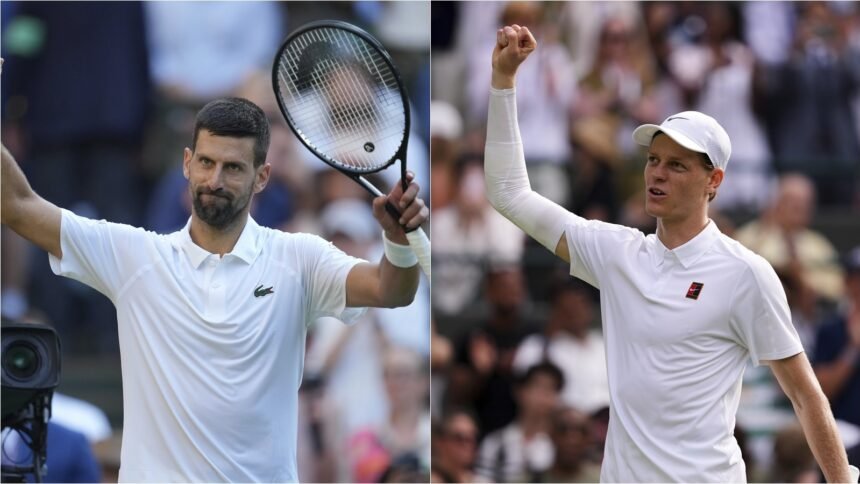A little over a month ago, following a straight-sets humbling at the hands of the world’s best player, Jannik Sinner, at the French Open, Novak Djokovic had been bleak in his appraisal of the match. He acknowledged he was well beaten and cast doubts over his future, even claiming he is unsure whether he will arrive in Paris to play on the crushed red brick ever again.
A rider was to come with his pessimism, though. “I guess my best chances maybe are Wimbledon, you know, to win another slam,” he said.
He will have the opportunity to confirm his telling this week. Following a fortnight in which he has given the world the entire Djokovic experience – swatting aside challengers in the first week and then picking himself up after slow starts against tougher opponents – the Serb is in the semifinals of Wimbledon again, for a 14th time at SW19 and 52nd time at a Major. Up against him will be Sinner once more, in a highly anticipated encounter between the World No.1 and the seven-time former champion on Centre Court on Friday.
 Jannik Sinner, the World No. 1 and new dominant force in men’s tennis, ran Djokovic ragged, beating him 6-4, 7-5, 7-6 (3) in their French Open semifinal late on Friday. (AP)
Jannik Sinner, the World No. 1 and new dominant force in men’s tennis, ran Djokovic ragged, beating him 6-4, 7-5, 7-6 (3) in their French Open semifinal late on Friday. (AP)
The Serb, on a quest for a record-extending 25th Grand Slam title, has looked more assured of his game and his tactics even when put under pressure or put through long physical tasks. Sinner arrives with the intimidating aura of his dominance, having dipped a bit.
The 23-year-old had match points in the French Open final but still lost to Carlos Alcaraz, who plays the other semifinal against Taylor Fritz on Friday. He is fortunate to have reached the semifinals altogether, after his fourth-round opponent, Grigor Dimitrov, was forced to retire despite a 2-0 sets lead after tearing his pectoral muscle.
Sinner had fitness concerns of his own after an awkward fall on his right elbow at the start of that match, and although he played his quarterfinal in a protective sleeve, his straight-sets domination of Ben Shelton on Wednesday suggested he is not physically compromised. He would later confirm as much, saying he expected to be “100% fit” for the semifinal.
Their record provides plenty of intrigue. Sinner leads 5-4; they both have won 2 matches each at Grand Slams, and the Serb beat Sinner both times they played at Wimbledon, once recovering from a two-set deficit. The more telling record, though, is of Sinner having won each of their last four meetings, a run that goes back to November 2023.
Story continues below this ad
So, how exactly can Djokovic go about turning that recent record? Some answers may lie in the French Open setback.
Forward not backwards
Comparisons with Djokovic have gone through Sinner’s entire career, and the eye test justifies that. Both are aggressive baseliners with a preference for hard courts, sticking tight to the baseline and taking balls high and early when needed. Both are elite returners. Both cover the court with aplomb.
And both are commandeers of the baseline: Djokovic through his acute creation of angles and point construction, Sinner through the power that comes from the purity of his ball-striking. Sinner’s power has trumped Djokovic’s accuracy in recent times. In Paris, the match may have been closer than the straight-sets scoreline suggested, but one area in which Sinner was decidedly superior was the baseline exchanges. Djokovic won just a measly 42% of the points from the back of the court – usually his domain – which means that his primary strategy must involve taking Sinner out of his comfort zone from the baseline.
 Jannik Sinner, left, of Italy is congratulated by Novak Djokovic of Serbia following their semifinal at the Australian Open tennis championships at Melbourne Park, Melbourne, Australia. (AP | PTI)
Jannik Sinner, left, of Italy is congratulated by Novak Djokovic of Serbia following their semifinal at the Australian Open tennis championships at Melbourne Park, Melbourne, Australia. (AP | PTI)
Two things may work comfortably in his favour here. The first being that grass is a surface where dogged baseline exchanges can be minimised, and variety is most useful. The second being that said variety is not Sinner’s strong suit. The Italian can slice, volley and drop shot his way out of trouble, but it is not his natural playing style. Djokovic, meanwhile, has the most complete toolbox in tennis history, and much of his success for this encounter may rely on how much he can move Sinner – sideways and forwards – by mixing things up.
Story continues below this ad
Shortening the points
In previewing his match against Sinner after the quarterfinal on Wednesday, Djokovic said he is feeling more at ease since Paris and is hitting the ball much better. Instead of the game, it is the physical challenge that he is more worried about.
That will require the Serb to avoid slugfests from the baseline with the best in the world at that particular pattern of play. Sinner’s recent dominance of the tour has come from how repetitively and consistently he pulverises the ball from the back of the court. Getting into those battles will likely not yield much of a result, as the big-hitting Shelton realised in their quarterfinal.
Instead, Djokovic must find a way to shorten the rallies by controlling the controllables. His serve has been looser than usual, getting broken eight times in his last two matches. But his first strike is superior to that of the World No. 1, and if he locks in on it, not only will he be able to create more breakpoint opportunities, but he will also be able to hold his nerve better on tiebreakers.
That will also involve him returning with more gusto. Block returns and merely getting the ball back into play will do little damage to Sinner, whose forehand performance has been unquestionably elite this tournament. Instead, it is the crafty angles and depth of return that Djokovic – and sometimes only he – can find.
Story continues below this ad
The Serb may need some of the vintage stuff and some newly added variety to get over this hurdle.








